The Dash Panel[1] (ダッシュパネル, Dasshu Paneru?), also known as the Dash Zone[2] (ダッシュゾーン, Dasshu Zōn?), Dash Pad[3], Boost Strips or Booster,[1] is a gimmick that appears in the Sonic the Hedgehog series. They are panels that allow the player to reach top running speed, and are even used to change the player's direction immediately. Dash Panels are usually placed in the high-speed sections of the Zones.
The Dash Panels appeared as early as in Sonic the Hedgehog 2, but it was not until Sonic Adventure that they became a frequently featured gimmick in the Sonic the Hedgehog series.
Description
The Dash Panels' primary function is to send the playable character running forward with a burst of speed that exceeds the speed of sound.[4] As soon as the playable characters touch a Dash Panel, they will automatically initiate a running dash away from the Dash Panel at their maximum running speed. However, Dash Panels can in most cases only launch the playable characters in one direction.
Dash Panels are always placed on solid surfaces and are usually used to help the player move through sections and across gimmicks where high-speed momentum is needed. As such, they are commonly placed on steep hills, close to loops, runnable walls and ceilings, or along straight paths. In some games, however, Dash Panels can be placed in locations that make it impossible for the player to backtrack in the levels. In some of the 3D games, Dash Panels are also placed in their own individual locations. However, there are cases where they are lined up so they cover the whole width of the pathway. Overall, the Dash Panels' placements come down to the scope of the route they are on.
While usually used to reach maximum running speed, Dash Panels also serve in many automated sections of the levels to guide the playable character down certain pathways by shooting them in the right direction. Also, in several games, using the Dash Panel can make the playable character automatically use the Spin Attack when touching it.
The appearance of the Dash Panels have been changed frequently over the course of the series. In the first games, they were booster mechanisms, which are referred to as Boosters.[note 1] These devices have lines of endlessly running wheels that push the playable character forward when they run in-between them. This design has appeared in several early (or classic) games such as Sonic Chaos and Sonic the Hedgehog Triple Trouble. In several early games, their design were also changed somewhat for each Zone to fit their environment. Sometimes, they could even function differently.
While a more flat panel design was introduced in Sonic Blast, it was not until in Sonic Adventure that they were redesigned as flat plates with endless moving treadmills on them, which were named Dash Panels. This design for the Dash Panel usually have a yellow, red and gray color scheme with arrows on their running treadmill parts, and is mainly reserved for modern games. Since Sonic the Hedgehog 4, though, the Booster design from early games has been reused in modern games such as Sonic Lost World and Sonic Forces.
Game appearances
Sonic the Hedgehog 2
Two types of Dash Panels were first introduced in Sonic the Hedgehog 2.

The first and most basic type of the Dash Panels appear in Chemical Plant Zone, and feature the Booster design. These Boosters are larger than the playable characters. They consist of a pair of spinning black wheels and have a glittering arrow on them. These gimmicks are placed in the more fast-paced and linear parts of the Zone.
![]() The second type of Dash panels resemble plane launchers and appear in Wing Fortress Zone. These pads launch the player far into the air while propelling them forward. Pressing down on
The second type of Dash panels resemble plane launchers and appear in Wing Fortress Zone. These pads launch the player far into the air while propelling them forward. Pressing down on ![]() when the playable character is fired away, however, will minimize the distance the player is thrown. When the player is standing on these pads, they can jump off them as well. After being used, these pads will move back to their standard position.
when the playable character is fired away, however, will minimize the distance the player is thrown. When the player is standing on these pads, they can jump off them as well. After being used, these pads will move back to their standard position.
Sonic the Hedgehog CD
![]() In Sonic the Hedgehog CD, the Windows 95 version, and the 2011 remaster, Dash Panels only appear in Stardust Speedway. Here, they resemble gray protrusions from the ground. When using these Dash Panels, the playable characters will create flame-like trails behind them as they shoot forward. Strangely, these Dash Panels disperse shell casings when used. Also, as a rare exception, these Dash Panels can propel the users forward in both the left and right direction. They are also good to use on linear sections when attempting to enter the Time Warp.
In Sonic the Hedgehog CD, the Windows 95 version, and the 2011 remaster, Dash Panels only appear in Stardust Speedway. Here, they resemble gray protrusions from the ground. When using these Dash Panels, the playable characters will create flame-like trails behind them as they shoot forward. Strangely, these Dash Panels disperse shell casings when used. Also, as a rare exception, these Dash Panels can propel the users forward in both the left and right direction. They are also good to use on linear sections when attempting to enter the Time Warp.
In the Special Stages, there are two types of plates with flashing arrows on them called Dash Zones[2] (ダッシュゾーン, Dasshu Zōn?). Regular Dash Zones are medium-sized, while Mini Dash Zones (ミニダッシュゾーン[5], Mini Dasshu Zōn?) are smaller. Otherwise, they work like regular Dash Panels. However, they make navigating the Special Stages harder.
Sonic Chaos
![]() In Sonic Chaos, the Dash Panels resemble those from the Chemical Plant Zone in Sonic the Hedgehog 2, giving them the Booster design by default. In this game, their color scheme differs between each Zone due to palette limitations. They also make the playable character use the Spin Attack upon using then. In this game, the Boosters appear in the more linear sections of Sleeping Egg Zone, Aqua Planet Zone and Electric Egg Zone.
In Sonic Chaos, the Dash Panels resemble those from the Chemical Plant Zone in Sonic the Hedgehog 2, giving them the Booster design by default. In this game, their color scheme differs between each Zone due to palette limitations. They also make the playable character use the Spin Attack upon using then. In this game, the Boosters appear in the more linear sections of Sleeping Egg Zone, Aqua Planet Zone and Electric Egg Zone.
Sonic the Hedgehog 3 & Knuckles
![]() In Sonic the Hedgehog 3 and the lock-on game Sonic 3 & Knuckles, gimmicks similar to the Dash Panels appear with different looks depending on the Zone they are found. In Carnival Night Zone, unnamed, similar-looking Dash Panels magnetically warp the player through them. As a side-effect, the player cannot backtrack through such tunnels. Also, in Launch Base Zone, Dash Panels, literally known as Fast Forwards,[6] launch the player forward with a segmented pole that is raised up from the ground.
In Sonic the Hedgehog 3 and the lock-on game Sonic 3 & Knuckles, gimmicks similar to the Dash Panels appear with different looks depending on the Zone they are found. In Carnival Night Zone, unnamed, similar-looking Dash Panels magnetically warp the player through them. As a side-effect, the player cannot backtrack through such tunnels. Also, in Launch Base Zone, Dash Panels, literally known as Fast Forwards,[6] launch the player forward with a segmented pole that is raised up from the ground.
![]() In Sonic & Knuckles and Sonic the Hedgehog 3 & Knuckles, Flying Battery Zone and Death Egg Zone feature plane launchers that look and function similar to those in Wing Fortress Zone in Sonic the Hedgehog 2, but their design slightly varies and they do not lift the playable character off the ground.
In Sonic & Knuckles and Sonic the Hedgehog 3 & Knuckles, Flying Battery Zone and Death Egg Zone feature plane launchers that look and function similar to those in Wing Fortress Zone in Sonic the Hedgehog 2, but their design slightly varies and they do not lift the playable character off the ground.
Sonic the Hedgehog Triple Trouble
![]() In Sonic the Hedgehog Triple Trouble, the Dash Panels have the same design they had in Sonic Chaos, giving them the Booster design by extension. Unlike those in Sonic Chaos, however, these Boosters do not force the playable characters to use the Spin Attack and they only give a small speed boost. They generally appear in Meta Junglira Zone, where they have a wooden look, and rarely in Atomic Destroyer Zone.
In Sonic the Hedgehog Triple Trouble, the Dash Panels have the same design they had in Sonic Chaos, giving them the Booster design by extension. Unlike those in Sonic Chaos, however, these Boosters do not force the playable characters to use the Spin Attack and they only give a small speed boost. They generally appear in Meta Junglira Zone, where they have a wooden look, and rarely in Atomic Destroyer Zone.
Sonic 3D Blast
![]() In Sonic 3D Blast, the Dash Panels have a different design and functionality. Here, they are at first a plate with arrows, but when Sonic stands on them, a blue wheel will appear behind him and rev him up as he Spin Dashes, before launching him forward.
In Sonic 3D Blast, the Dash Panels have a different design and functionality. Here, they are at first a plate with arrows, but when Sonic stands on them, a blue wheel will appear behind him and rev him up as he Spin Dashes, before launching him forward.
In this game, the Dash Panels are generally used to automatically travel between the sections of a Zone, or to travel uphill. Also, in front of the Dash Panels that leads to another section are purple gates that prevent the player from passing through them unless they use the Dash Panels.
The player is unable to backtrack down the same path used by the Dash Panels, but they can use alternate paths to return to previous sections. In the Sega Saturn version of the game, the Special Stages also have red gates which can lead Sonic through strings of Rings with a speed boost, similar to the Dash Panels.
Sonic Blast
![]() In Sonic Blast, the Special Stages have more panel-like Dash Panels, giving them the appearance of the modern Dash Panel. In this game, they are flat and blue with yellow arrows on their running treadmills. They are usually placed in front of strings of Rings to make it easier for the player to collect said Rings with the speed boost they give (which lasts for a few seconds).
In Sonic Blast, the Special Stages have more panel-like Dash Panels, giving them the appearance of the modern Dash Panel. In this game, they are flat and blue with yellow arrows on their running treadmills. They are usually placed in front of strings of Rings to make it easier for the player to collect said Rings with the speed boost they give (which lasts for a few seconds).
Sonic Adventure
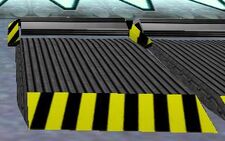
In Sonic Adventure and its enhanced port Sonic Adventure DX: Director's Cut, the Dash Panels are referred to as dash panels[7] and appear as a main gimmick for the first time, featuring an early modern design. In these games, the dash panels are rectangular plates with a grey treadmill on them that runs endlessly, and yellow and black hazard stripes on the front and rear. They are usually set individually on narrow routes, though there can be more than two or three of them set in wider areas where momentum is needed. When used by Sonic, he can only go faster than he already is by using the Spin Dash.
Sonic Adventure 2

In Sonic Adventure 2 and its enhanced port Sonic Adventure 2: Battle, the Dash Panels still feature the modern Dash Panel design, but are more advanced-looking than in Sonic Adventure. In this game, they are still rectangular, but with wider bottom edges and yellow and black hazard stripes on the sides. They also have treadmills with grey arrows on them, red side-edges on the front, and smaller black treadmills with red arrows on them on the rear.
In these games, the Dash Panels are generally featured in High-Speed Action Stages and Shooting Stages. Like in Sonic Adventure, narrow sections use lone Dash Panels to provide much-needed momentums. However, several wider areas utilize larger lines of Dash Panels than in Sonic Adventure.
Sonic Advance series
Sonic Advance
![]() In Sonic Advance, the Dash Panels' design borrows mostly from their Booster design, being small yellow plates with orange running wheels on them. They also appear more often in the Acts than in most other games, a factor of which occurs in all subsequent entries in the Sonic Advance series.
In Sonic Advance, the Dash Panels' design borrows mostly from their Booster design, being small yellow plates with orange running wheels on them. They also appear more often in the Acts than in most other games, a factor of which occurs in all subsequent entries in the Sonic Advance series.
Sonic Advance 2
In Sonic Advance 2, the Dash Panels look exactly like they did in Sonic Advance. Occasionally though, the Dash Panels' appearance is changed to fit a Zone's atmosphere, such as in Techno Base. In addition, when using the Dash Panel in this game, the player automatically enters Boost Mode.
Sonic Advance 3
In Sonic Advance 3, the Dash Panels look exactly like they did in Sonic Advance and Sonic Advance 2. Like in the previous title, their appearance might change according to their Zone's atmosphere. They also retain their Boost Mode-activating mechanic.
Sonic Battle
![]() In Sonic Battle, the Dash Panels' design are identical to the one they had in Sonic Adventure 2. In this game, the Dash Panels only appear in the Shadow's Speed Demon mini game, where they grant a small speed boost to the playable characters when run over. In addition, running over multiple Dash Panels in succession will increase the playable characters' speed gradually.
In Sonic Battle, the Dash Panels' design are identical to the one they had in Sonic Adventure 2. In this game, the Dash Panels only appear in the Shadow's Speed Demon mini game, where they grant a small speed boost to the playable characters when run over. In addition, running over multiple Dash Panels in succession will increase the playable characters' speed gradually.
Sonic Heroes

In Sonic Heroes, the Dash Panels have a new design that is closer to the modern Dash Panels'. In this game, they are flat, rectangular plates with a gray running treadmill on them. These treadmills have red arrows on them showcasing the direction they sent the playable character in. They also have orange frames on the sides which are extra thick on the lower sides and colored red on the bottom.
In this game, Dash Panels usually appear in rows of three and their main function is to guide the player rather than increasing their speed. Additionally, Pinball tables in Casino Park, BINGO Highway and Pinball Match have flashing neon orange arrows which function like Dash Panels. The Special Stages in the game also have different, flashing panels in rows. Due to the nature of the game, whenever the player uses a Dash Panel, their playable characters' perspective aura will appear ahead of them, similar to when using a Dash Ring.
Aside from regular Dash Panels, Sonic Heroes also introduced the Dash Rail, which are essentially Dash Panels on Grind Rails.
Shadow the Hedgehog

In Shadow the Hedgehog, the Dash Panels have the same design they had in Sonic Heroes, except their orange frames are duller and their bottoms are grey. Other than that, everything about them are the same as in Sonic Heroes.
Sonic Rush series
Sonic Rush

In Sonic Rush, the Dash Panels returned to their Booster design. In this game, they look exactly like they did in the Sonic Advance titles. They also retain their ability to allow the player to enter Boost Mode when using them.
In the game's Special Stages, Dash Panels are used to guide the player through the lines of Rings. Also, their design in the Special Stages vaguely resemble the one in Sonic Heroes, with them being black treadmills with magenta arrows on them and red and orange-striped edges on the sides.
Sonic Rush Adventure
In Sonic Rush Adventure, the Dash Panels only appear in the Acts. They also look and behave exactly like they did in Sonic Rush.
Sonic Riders series
Sonic Riders
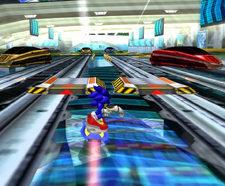
In Sonic Riders, the Dash Panels have their modern design. In addition, they look virtually identical to how they appeared in Sonic Adventure 2. In this game, they can either be set in long rows to guide the racers and give them extra speed, or individually to guide the player through narrow pathways.
Sonic Riders: Zero Gravity
In Sonic Riders: Zero Gravity, the Dash Panels retain their Dash Panel design from Sonic Riders. In gameplay, they serve the same roles they did in the previous title as well.
Sonic Free Riders
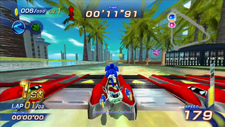
In Sonic Free Riders, the Dash Panels' designs were once based on the modern Dash Panel. This time however, their design resembles more the one they have in Sonic Unleashed and Sonic Colors. In gameplay, they serve the same roles they did in the previous Sonic Riders titles.
Sonic the Hedgehog (2006)

In Sonic the Hedgehog (2006), the Dash Panels have the same modern Dash Panel design they had in Sonic Heroes. In this game, many of them are placed by themselves rather than in rows and serve primarily to guide the player's direction. Due to the game's incomplete development, the Dash Panels can sometimes glitch, resulting in the player running into an invisible wall or steering away from strings of Rings. The Dash Panels can also glitch when using the Psycho Shock on them, delaying its speed boost until the player jumps.
When using a Dash Panel, the player will be unable to control the playable character for a short time. For Sonic and Shadow, the Dash Panels are mostly used to grant then a boost of speed. In Silver's case, they are just used to direct him, since they do not work properly on him.
Sonic Rivals series
Sonic Rivals
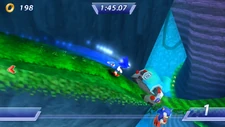
In Sonic Rivals, the Dash Panels have a drastically different design in the regular Zones. In this game, they are gray treadmill panels set between two white high-tech posts, but otherwise give the Dash Panel's speed boost when passing through them. They are usually placed at wide pathways, loops and slopes.
Sonic Rivals 2
In Sonic Rivals 2, the Dash Panels look exactly like they did in Sonic Rivals. Like in Sonic Rivals, they are usually placed at wide pathways, loops and slopes.
Sonic Storybook Series
Sonic and the Secret Rings
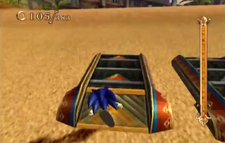
In Sonic and the Secret Rings, the Dash Panels' overall appearance is the same as the modern Dash Panel design featured in Sonic Heroes and Sonic the Hedgehog (2006). These Dash Panels however, are given a more yellow color scheme and artistic details to fit the world of the Arabian Nights. Like in the previous games, they are most of the time either set in rows or placed individually, depending on the route's scope.
Sonic and the Black Knight
In Sonic and the Black Knight, the Dash Panels' design is derived from the modern Dash Panel design featured in Sonic Unleashed. In this game, they are encountered exclusively in the game's Legacy Missions. Like in the games before it, they appear mostly in rows, but can also appear individually, depending on the scope of the road.
Sonic Unleashed

In the Xbox 360/PlayStation 3 version and Wii/PlayStation 2 version of Sonic Unleashed, the Dash Panels are designed like the modern Dash Panels. They look much like they did in Sonic Heroes, except the sides of their frames are now red and the arrows on their treadmills are now orange. In this game, they only appear in the daytime Action Stages, where they are either placed individually in the 2.5D sections of the Acts and in rows of three-to-five in the 3D sections.
In the Wii/PlayStation 2 version of Sonic Unleashed, when Sonic runs past a Dash Panel while using the Sonic Boost, Sonic will do a Spin Dash animation.
Sonic the Hedgehog 4
Sonic the Hedgehog 4: Episode I

In Sonic the Hedgehog 4: Episode I and its extension Sonic the Hedgehog 4: Episode Metal, the Dash Panels have their Booster-design from the early installments in the series. In these games, they are attachments with four rapidly spinning red-orange wheels on a gray plate that has arrows on it.
Unlike in the early games, the Boosters appear more often and are featured in every Zone. Also, like in Sonic Chaos, the Boosters make the playable character use the Spin Attack upon using them.
Sonic the Hedgehog 4: Episode II
In Sonic the Hedgehog 4: Episode II, the Dash Panels in the regular Zones retain their Booster-design from Sonic the Hedgehog 4: Episode I. They also possess the same Spin Attack-inducing mechanic they had in the previous title.
Like in Sonic the Hedgehog 4: Episode I, the Boosters appear in every Zone in the game. Modern Dash Panels (which resemble those seen in Sonic Unleashed) also appear in the Special Stages. In these Stages, they are placed individually and serve to direct the player through strings of Rings.
Sonic Colors
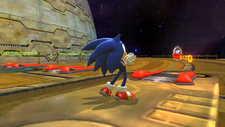
In the Wii version of Sonic Colors and its remaster Sonic Colors: Ultimate, the Dash Panels possess their modern Dash Panel design, which looks exactly like the one they had in Sonic Unleashed. In this version of the game, they are placed individually in the 2.5D sections of the Acts and in long rows in the 3D sections.
In the Nintendo DS version of Sonic Colors, the Dash Panels possess their Booster design, which looks like the one they had did in the Sonic Rush titles. In this version of the game, like in Sonic Advance 2-3 and the Sonic Rush titles, using these Dash Panels make the player enter the Boost Mode.
Sonic Generations
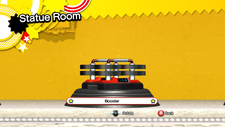
In the console/PC version and Nintendo 3DS version of Sonic Generations, the Dash Panels come in two different designs. However, they both function in the same way. Act 1 of each Stage feature the original Boosters from earlier games; these devices consist of rapidly spinning black wheels on red and black platforms. Act 2 of each Stage on the other hand feature the modern Dash Panels; these devices look like the Dash Panels in Sonic Unleashed.
When using the Dash Panels in the Nintendo 3DS version of Sonic Generations, both Modern and Classic Sonic will automatically use their Spin Attack, much like in Sonic Chaos. On the console/PC versions of the game however, only Modern Sonic will use the Spin Attack (albeit briefly) whenever he runs over a Dash Panel at certain speeds.
In the console/PC version of the game, the Boosters also have their own trophy in the hidden Statue Room.
Sonic Lost World
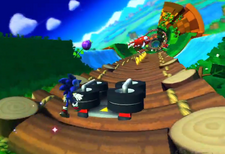
In the Wii U version, PC version and Nintendo 3DS version of Sonic Lost World, the Dash Panels have the original Booster-design from the early installments of the series. This time around, they look identical to the Boosters seen in Sonic Generations. However, their placements within the Zones are somewhat unusual, as they can be placed on narrow steep roads or inside tubular pipes.
Like in previous games, rows of three or five Boosters appear in the 3D sections of the game for the sake of giving the player a boost of speed, while other are placed individually to guide the player. Along with the Spin Dash, the Boosters are the only way for Sonic to reach maximum running speed.
Sonic Mania
In Sonic Mania and its expansion Sonic Mania Plus, the Dash Panel in itself does not appear. However, the game does reuse several other Dash Panel-like gimmicks from previous games. These gimmicks work exactly like they did in their original games and include the following variations:
- The Booster-based mechanism from Chemical Plant Zone in Sonic the Hedgehog 2. They are only encountered in Chemical Plant Zone.
- The plane launchers from Flying Battery Zone and Death Egg Zone in Sonic & Knuckles that give a forward boost of speed. They are only encountered in Flying Battery Zone.
- The gray ground protrusions from Stardust Speedway in Sonic the Hedgehog CD that can give a boost of speed in either direction. They are only encountered in Stardust Speedway Zone.
Sonic Forces
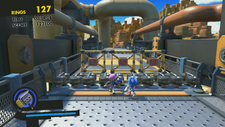
In Sonic Forces, the Dash Panels are featured as a main gimmick. In this game, they have their original Booster design from earlier games, with rapidly spinning black wheels on red and black platforms with arrow-marked treadmills running along them. Unlike in Sonic Generations, these Boosters appear in every stage, including those not exclusive to Classic Sonic.
In gameplay, the Boosters are placed individually in the 2.5D sections of the stages and in long rows in the 3D sections
Sonic Frontiers
In Sonic Frontiers, Dash Panels appear as common gimmicks. In the game's Open Zone areas, they possess slightly altered modern designs, with purple edges and glowing cyan arrows. In Cyber Space stages, however, Dash Panels appear sporadically in two, recent designs from previous mainline games: the regular panel and Booster designs.[8][9]
Sonic Dream Team
In Sonic Dream Team, Dash Panels appear as a common gimmick in the stages. In this game, they retain their design since Sonic Unleashed, albeit with some differences. They sport a much longer stretched-out design, and have purple arrows on the treadmill part instead of yellow like usual. They retain their red side frames and blue and black back-pieces however.
Other game appearances
Sonic the Hedgehog Pocket Adventure
![]() In Sonic the Hedgehog Pocket Adventure, there are Booster-based Dash Panels similar to those that appeared in Chemical Plant Zone in Sonic the Hedgehog 2. These Boosters only appear in Secret Plant Zone. Plane launcher-like plates also appear in Aerobase Zone which function like those in Wing Fortress Zone in Sonic the Hedgehog 2.
In Sonic the Hedgehog Pocket Adventure, there are Booster-based Dash Panels similar to those that appeared in Chemical Plant Zone in Sonic the Hedgehog 2. These Boosters only appear in Secret Plant Zone. Plane launcher-like plates also appear in Aerobase Zone which function like those in Wing Fortress Zone in Sonic the Hedgehog 2.
Mario & Sonic series
Mario & Sonic at the Olympic Winter Games
In the Wii version of Mario & Sonic at the Olympic Winter Games, the Dash Panels possess the exact same design they had in Sonic Colors. In this game, they appear in the Individual Team version of the Dream Alpine event, the Individual and Team version of the Dream Snowboard Cross event, the Dream Short Track event, and the Dream Bobsleigh event. Here, they typically appear in groups of two-to-three, often near narrow passages along the course.
Mario & Sonic at the Sochi 2014 Olympic Winter Games
In Mario & Sonic at the Sochi 2014 Olympic Winter Games, the Dash Panels are given the same appearance they had in Sonic Generations. In this game, they appear in the Roller Coaster Bobsleigh event, where they typically appear in rows. Notably, when using a Dash Panel in this game, the user's bobsleigh will temporarily be surrounded by a colored aura.
Mario & Sonic at the Rio 2016 Olympic Games
in the Nintendo 3DS version of Mario & Sonic at the Rio 2016 Olympic Games, the Dash Panels sport their modern designs from Sonic Generations. In this game, the Dash Panels serve as one of the items that can appear along the track in the 100m Plus event, namely by choosing it from on the roulette at the beginning of the event. If chosen, several Dash Panels travel forwards at varying speeds and will grant a speed boost when ran over. Also, in the BMX Plus event, Dash Panels appear in various places along the course to give the contestants speed boosts, and come in stationary and moving varieties. The Dash Panels also appear as stationary gimmicks in the Equestrian Plus event where they grant the standard speed boost.
Mario & Sonic at the Olympic Games Tokyo 2020
In the Nintendo Switch version of Mario & Sonic at the Olympic Games Tokyo 2020, both the classic and modern versions of the Dash Panel are featured. The classic Dash Panels (which are referred to as Boosters[10]) are identical to those from Chemical Plant Zone in Sonic the Hedgehog 2. The modern Dash Panels on the other hand, resemble those from Sonic Unleashed.
In this game, modern Dash Panels are featured in the Dream Racing event. Here, they appear either in rows that stretch across the entire road, or sequentially in rows of just two-to-three Dash Panels. The Boosters on the other hand appear only in the "Bullet Train Blast" mini-game, where they are used to give Sonic a brief increase in speed.
Sonic Chronicles: The Dark Brotherhood
In Sonic Chronicles: The Dark Brotherhood, the Dash Panels are more or less designed after the modern Dash Panel. In this game, they have grey edges and black and yellow arrows on them, much like in Sonic Adventure. In gameplay, they are only encountered during the running section that occurs when the player chooses the flee option in a battle or when an opponent tries to escape a battle. During this running section, the Dash Panels will appear along the path the playable characters are running, where they increase the characters' running speed briefly, thus improving the player's chances of reaching the end of the running section or catching up to the escaping opponents.
Sonic Dash
In Sonic Dash, the Dash Panels serve as minor objects when the player enters the loop-de-loop section. In this game, they are somewhat different with simple red and black colored panels with blue arrows on the treadmills. They are used to give small amount of increased speed when the player enters the loop or corkscrew in their sections. They also make the playable character perform the Spin Attack automatically.
Sonic Forces: Speed Battle
In Sonic Forces: Speed Battle, the Dash Panels are designed like the modern Dash Panels. In this game, they look almost identical to how they appeared in Sonic Unleashed, except these Dash Panels have blue-glowing arrow marks on their treadmills. In gameplay, Dash Panels are randomly placed in certain areas on the tracks.
Sonic Speed Simulator
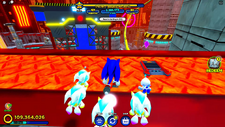
In Sonic Speed Simulator, the Dash Panels feature a slightly modified version their modern designs. In this game, they appear similar to how they looked like in Sonic Unleashed. However, their design is slightly altered featuring new minor details such as two small neon arrows on the rear floor of the dash pad, as well as the base of the dash pad being a light grey rather than black, these dash pads are a rather rare gimmick in this game, only appearing in a few select worlds, such as Chemical Plant.
In gameplay, Dash Panels only appear by themselves, and typically at the beginning of routes that require momentum, such as Grind Rails. Occasionally, they can even be found on top of Grind Rails.
Variants
Accelerators
Accelerators are objects similar to the Dash Panels, but with more parts to them. The more Rings the player has when passing through an Accelerator, the further distance will it send the player. To use it, the player must pay up to fifty Rings. They only appear in Sonic R.
Dash Ring
Dash Rings are another version of the Dash Panels. When passing through these rings, the player's character is send flying in the direction the Dash Ring is facing. Early on, they were designed as high-tech rings, but later became more generic orange rings. Since Sonic Heroes, Dash Rings have also come in a different variant called Rainbow Rings. They first appeared in Sonic Adventure.
Dash Rail
Dash Rails are another variant of the regular Dash Panels. They function similarly to their ground counterparts, but are meant to boost the users' speed when grinding on Grind Rails. They were first introduced in Sonic Heroes.
Drift Dash Panel
Drift Dash Panels are another variant of the regular Dash Panels. When going through them, instead of giving a boost in speed, they will make the player start Drifting. It only appeared in Sonic Frontiers.
Glove on a stick

Gloves on a stick are objects that behave similar to the Dash Panels. At first, they are hidden underneath the ground. However, when the player approaches, a hand-shaped object will rise and grab them, making them run on a small Conveyor Belt. Then, the hand will release the player and send them forward a high speed. This gimmick first appeared in Sonic the Hedgehog 3.
Jump Panel
Jump Panels were introduced early on in the series, but it was not until Sonic Adventure that they took up the properties of the Dash Panels. Unlike the Dash Panels, which send the player into a dash along the ground, these panels send the player flying into mid-air, usually for the purpose of getting to the other side of gaps. Since Sonic Adventure 2, they have branched into two types; regular panels and Trick Jump Panels. They first appeared in Sonic the Hedgehog 2.
Turquoise Fairies
Turquoise Fairies are one of seven types of fairies. They hover in clusters and function like a Dash Panel when touching them. Like regular Dash Panels, they are placed in different sizes of rows. They only appear in Sonic and the Black Knight.
Triple Dash Pads
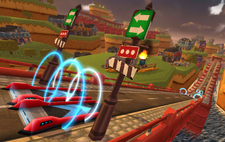
Triple Dash Pads are a variant of regular Dash Panels. They appear as slightly larger Dash Panels with a light blue ring vertically surrounding them. When passed through, they will give the user a short boost of speed and a colorful aura. The amount of speed given increases for each consecutive Triple Dash Pad that is passed through by the player. The first aura is colored cyan, followed by yellow, and finally purple, which represents the greatest amount of speed which can be reached by using them. Their first and only appearance is in Sonic Forces: Speed Battle.
Trivia
- Sonic Pinball Party features the Dash Panel briefly as part of the plunger in each Sonic-themed pinball table in the game.
- If the player does an extremely hard glitch in Eggmanland in Sonic Unleashed, the player can reach the Hedgehog section as the Werehog. The player can be on the Dash Panel. It would play the usual sound effect, yet won't make the Werehog dash forward.
See also
Notes
- ↑ None of the booster mechanisms were named or mentioned in the earlier installments in the series. The name "Booster" was given for the Dash Panels in the classic stages in the console/PC versions of Sonic Generations and the name is used for them in the trophy room and instruction manuals.
References
- ↑ 1.0 1.1 Sonic Generations (Xbox 360) United Kingdom instruction booklet, pg. 10.
- ↑ 2.0 2.1 Sonic the Hedgehog CD (Sega CD) United States instruction booklet, pg. 16.
- ↑ Sega Europe, Hardlight (2 November 2017). Sonic Forces: Speed Battle. iOS. Sega. "Loading screen: Get rollin' around at the speed of sound! Use Dash Pads 50 times."
- ↑ BradyGames (1 November 2011). Sonic Generations Official Strategy Guide. BradyGames. p. 15. ISBN 978-0744013429.
- ↑ Sonic the Hedgehog CD (Mega-CD) Japanese instruction booklet, pg. 23.
- ↑ Hill, Simon (June 1994). "Launch Base". The Official Sonic 3 Play Guide. Titan Books. p. 81. ISBN 978-1852865672.
- ↑ Sonic Team . Sonic Adventure Online. Sonic for Beginners - Point 4. Retrieved on 8 July 2022. "POINT 4: SPRINGS & DASH PANELS - There are a number of useful devices that can be found in the action stages. Springs and dash panels can be used to send Sonic to a whole new area. Whenever you find one, be sure to give it a try."
- ↑ Sonic Stadium ✪ Sonic News & Community (@sonicstadium) on Twitter. Twitter (24 August 2022). Retrieved on 24 August 2022. "Sonic Stadium: Someone (not us) playing the Green Hill Zone Cyberspace stage. Very short and sweet stages. Why you side-stepping, bro #SonicFrontiers"
- ↑ Dreed (@whyyydreed) on Twitter. Twitter (26 August 2022). Retrieved on 28 August 2022. "Dreed: Sonic Frontiers - City Level (Gamescom Demo)"
- ↑ Sega (5 November 2019). Mario & Sonic at the Olympic Games Tokyo 2020. Nintendo Switch. Sega. Area/Level: Bullet Train Blast. "Bullet Train Blast rules: Collect items like Shield and Invincibility by touching them. Passing through Boosters will temporarily increase your speed."